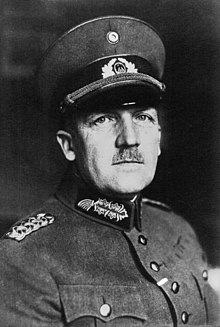
Back Kurt von Schleicher AN كورت فون شلايشر Arabic كورت فون شلايشر ARZ Kurt fon Şleyxer Azerbaijani Курт фон Шлейхер Byelorussian Курт фон Шлайхер Bulgarian Kurt von Schleicher Catalan Kurt von Schleicher Czech Kurt von Schleicher Danish Kurt von Schleicher German
Kurt von Schleicher | |
|---|---|
 Schleicher in 1932 | |
| Chancellor of Germany | |
| In office 3 December 1932 – 30 January 1933 | |
| President | Paul von Hindenburg |
| Preceded by | Franz von Papen |
| Succeeded by | Adolf Hitler |
| Reichskommissar of Prussia | |
| In office 3 December 1932 – 30 January 1933 | |
| Preceded by | Franz von Papen |
| Succeeded by | Franz von Papen |
| Minister of Defence | |
| In office 1 June 1932 – 30 January 1933 | |
| Chancellor | Franz von Papen Himself |
| Preceded by | Wilhelm Groener |
| Succeeded by | Werner von Blomberg |
| Personal details | |
| Born | Kurt Ferdinand Friedrich Hermann von Schleicher 7 April 1882 Brandenburg an der Havel, Brandenburg Province, Kingdom of Prussia, German Empire |
| Died | 30 June 1934 (aged 52) Potsdam-Babelsberg, Nazi Germany |
| Spouse |
Elisabeth von Schleicher
(m. 1931) |
| Alma mater | Prussian Military Academy |
| Occupation |
|
| Military service | |
| Allegiance | |
| Branch/service | Imperial German Army Reichsheer |
| Years of service | 1900–1932 |
| Rank | General der Infanterie |
| Battles/wars | World War I |
| This article is part of a series on |
| Conservatism in Germany |
|---|
 |
Kurt Ferdinand Friedrich Hermann von Schleicher (pronounced [ˈkʊʁt fɔn ˈʃlaɪçɐ] ⓘ; 7 April 1882 – 30 June 1934)[1] was a German general and the penultimate chancellor of Germany during the Weimar Republic. A rival for power with Adolf Hitler, Schleicher was murdered by Hitler's SS during the Night of the Long Knives in 1934.
Schleicher was born into a military family in Brandenburg an der Havel on 7 April 1882. Entering the Prussian Army as a lieutenant in 1900, he rose to become a General Staff officer in the Railway Department of the German General Staff and served in the General Staff of the Supreme Army Command during World War I. Schleicher served as liaison between the Army and the new Weimar Republic during the German Revolution of 1918–1919. An important player in the Reichswehr's efforts to avoid the restrictions of the Treaty of Versailles, Schleicher rose to power as head of the Reichswehr's Armed Forces Department and was a close advisor to President Paul von Hindenburg from 1926 onward. Following the appointment of his mentor Wilhelm Groener as Minister of Defence in 1928, Schleicher became head of the Defence Ministry's Office of Ministerial Affairs (Ministeramt) in 1929. In 1930, he was instrumental in the toppling of Hermann Müller's government and the appointment of Heinrich Brüning as Chancellor. He enlisted the services of the Nazi Party's SA as an auxiliary force for the Reichswehr from 1931 onward.
Beginning in 1932, Schleicher served as Minister of Defence in the cabinet of Franz von Papen. Schleicher organized the downfall of Papen and succeeded him as Chancellor on 3 December. During his brief term, Schleicher negotiated with Gregor Strasser on a possible defection of the latter from the Nazi Party, but the plan was abandoned. Schleicher attempted to "tame" Hitler into cooperating with his government by threatening him with an anti-Nazi alliance of parties, the so-called Querfront ("cross-front"). Hitler refused to abandon his claim to the chancellorship and Schleicher's plan failed. Schleicher then proposed to Hindenburg that the latter disperse the Reichstag and rule as a de facto dictator, a course of action Hindenburg rejected.
On 28 January 1933, facing a political impasse and deteriorating health, Schleicher resigned and recommended the appointment of Hitler in his stead. Schleicher sought to return to politics by exploiting the divisions between Ernst Röhm and Hitler but on 30 June 1934 he and his wife Elisabeth were murdered on the orders of Hitler during the Night of the Long Knives.
- ^ "Kurt von Schleicher 1882–1934". LeMO. Retrieved 2 August 2017.
© MMXXIII Rich X Search. We shall prevail. All rights reserved. Rich X Search